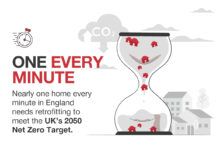
Highly anticipated, the publication of the consultation on the Future Homes and Building Standards will send shockwaves through the window and door industry but for a completely unexpected set of reasons, according to Rob McGlennon, managing director, Deceuninck.
A consultation document has rarely been anticipated more. After four years of speculation, the Consultation on the Future Homes and Buildings Standards was finally published on 13th December.
Having been braced for a new notional value for new build of 0.8 W/m2K, the news that there would be no further increase in performance beyond the 1.2W/m2K introduced in the revision of Part L in June 2022, was at once a relief and a disappointment.
A disappointment because as industry it is our role to look to the future, to innovate and to design and develop new and better windows and doors which require less energy and carbon in manufacture, and which deliver further carbon savings through life.
A relief because at an initial reading it appears that we won’t have to move to triple-glazing to meet future requirements, but that’s at the first reading. The consultation has an unexpected sting in its tail – The Home Energy Model.
This has ramifications almost as big for fabricators as any u-value of 0.8 W/m2K might have done because it has the potential to bring the industry back to exactly the same place – triple-glazing!
The proposed Home Energy Model is according to the authors of the consultation ‘based on the latest evidence and is more sophisticated than SAP’. In the belief that you get out, what you put in, they highlight that the use of the standard sizes to work out u-values is problematic.
The proposal instead is to use ‘either the actual size and configuration of the window or door, or measured using the appropriate hot box method set out in the BS EN ISO 12567 series’.
This effectively means modelling each specific window configuration – and that creates a challenge because most of windows supplied in a real-world context are smaller than the ‘standard’ window configuration (1230×1480 open/fixed).
The smaller the glazed area, the harder it is to achieve a u-value of 1.2 W/m2K. This is especially problematic where steel reinforcements are required.
If the model is adopted, for a lot of window and door systems that brings us right back to where we started, triple-glazing.
It will also place new onus on fabricators to evidence compliance on a product-by-product basis. It is worth noting that under current arrangements under Part L, the definition of ‘new build’ extends beyond volume installations to individual builds and extensions.
Again, we have to play the waiting game, to feedback on the consultation and play our cards once the dust settles and the regulation is written.
As a socially responsible business which is committed to positive environmental change, Deceuninck will continue to innovate regardless of regulation, developing new products which achieve consistently higher levels of energy efficiency – because ultimately, that is what homeowners want.



